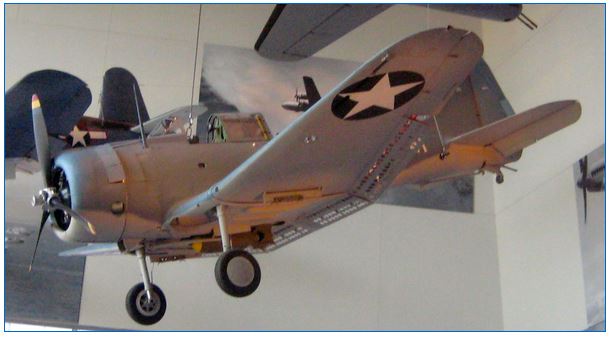
I was seated directly under the 500-pound bomb on the trapeze release under the Douglas Dauntless SBD dive-bomber the Navy taught Dad to fly down at NAS Pensacola. He told me the principle was fairly simple. Pop the big speedbrake flaps with the circular holes in them, point the nose of the airplane at the target and drop the bomb where the nose of the plane was pointed. Retract flaps and zoom away.
I hoped nothing was going to happen like that this morning, and that the aircraft riggers had done their job well. I don’t think I ever asked Dad what the aviation cadets in Pensacola thought about VE Day, and it didn’t occur to me when I had the chance. The Navy pilots all knew where they were going, and the fight in the Pacific was still going hot and heavy, and the prospect of invading the Home Islands must have filled them with dread.
I didn’t ask Mom, either, and she would have seen the crush of the crowds near where she worked for The Texas Company in the iconic art deco spire of the Chrysler Buidling in Midtown Manhattan. I don’t think we thought about what the news must have felt like that Hitler was dead and the Germans had quit the fight.
The Museum President’s secretary is Erin, and she was seated behind me. I turned around and we chatted as we waited for Dr. Donald “Nick” Mueller to welcome the crowd to the memorial service, she explained the delicate process of bringing the crown jewel to the Boeing Pavilion: up above the dive-bomber and the P-51 fighter and the Helldiver torpedo plane was a completely refurbished B-17 Flying Fortress. It literally obscured the ceiling of the glass-fronted soaring space.
“The bomber arrived on seven or eight trucks. They had to remove one of the wings to clear the catwalk so visitors can see it close up. And then they had to reassemble it after they hoisted it with several winches. Dr. Mueller said it was attending the birth of a child.”
“I believe it. This whole complex is extraordinary,” I said. “It is a collection that rivals the one at the Air and Space Museum downtown in Washington. Maybe not as broad, since the airplanes are all World War Two vintage, but this is amazing!”
“We started mostly with American airplanes, but there is a nice Supermarine Spitfire over in the other building.”
“I am looking forward to seeing it all- the Pullman rail car like the ones the G.I.s all traveled on, the armor and vehicle collection, the uniforms and artillery. This is incredible.”
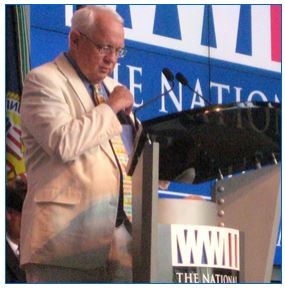
Dr. Mueller looked out on the crowd and got up and walked to the podium to give us some worlds of welcome to the Freedom Pavilion’s Boeing Center. “Seventy years ago today in a red brick schoolhouse in Reims, France, a delegation of Germans arrived to sign the instrument of unconditional surrender to the Allies. The terms of the treaty went into effect a minute before midnight, and Europe, after six blood-soaked years of conflict was at peace. A peace,” he added with solemn gravity, “that has continued to this day.” He glanced down at the program. “I am going to introduce our Master of Ceremonies, Bill Detweiler, He is a consultant for our Military and Veteran’s Affairs Division, and he will call for the Colors to be paraded.”
He nodded at Bill, who took his place at the podium. Then he looked to his left and called out: “Sergeant, parade the colors!”
Four soldiers in crisp dress blue uniforms, two with rifles and two with flags between them marched to the front of the rostrum with measured cadence and on command, turned to present arms. I saluted, since an Act of Congress gave veterans the right to render the hand salute rather than place hand over heart even when out of uniform. The Army flag was dipped below the National Ensign, which stood alone and tall.
Once the National Anthem had been played, Bill took over from Nick and introduced CAPT Stephen Shaw, USN, the Force Chaplain of Marine Forces Reserve in New Orleans gave a quiet but forceful prayer of remembrance. The hall was still.
We all said “Amen” when he was done, and Bill took the podium once more to give us a preview of what we were going to see. “First, our Senior Director of Research and History and Samuel Zemurry Stone Fellow Dr. Keith Huxen will give us the historical perspective on what the significance of VE Day means, and what happened at Ike Eisenhower’s Supreme Headquarters Allied Expeditionary Forces in the hours before dawn, seventy years before.
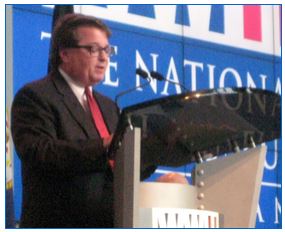
Ike didn’t attend the signing. He paced and smoked cigarettes until General Jodl had signed and was ushered down to see him. “Ike looked at him, and told him he was holding Jodl personally responsible for full compliance with the terms of surrender and then dismissed him. Then Ike made the radio broadcast of a lifetime, informing the world that as of that moment, the mission of his Command was achieved.”
The Professor went on to talk a little about what the world might have looked like if the Allied had not prevailed- Hitler’s vision for a happy Aryan Master race re-populating Eat Europe and ruling over Slavic slaves. Sterilized slaves. It was a sobering idea, hearing what the Nazi vision had been.
The crowd was silent when he was done. Then Bill took over for the heart of the program: the testimony of three people who were there on VE Day: A Vet, a Home Front defense worker, and a survivor of the Warsaw Ghetto.
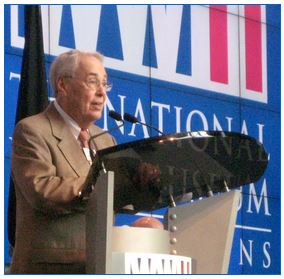
Introduced first was Bob Wolf, who had been an infantry soldier in Germany not far from Hitler’s Alpine Retreat. He described the sense of relief that suddenly came with the wary hope that every road junction was not pre-targeted by artillery to blow him to smithereens, and that every bend in the road did not come with an ambush by machine-gun armed SS Troopers.
They celebrated by getting a local guide to take them in the woods, where they shot a couple deer and ate well. The next day they ventured to Hitler’s compound, where the buildings above ground had been thoroughly trashed by Allied air strikes. “The tunnels below were in good shape, though. There was a whole city down there, guard-posts and meeting rooms and bedrooms. And the wine cellars. Very large wine sellers. Our problem was that the 101st Airborne had been there the day before, and there wasn’t a bottle left!”
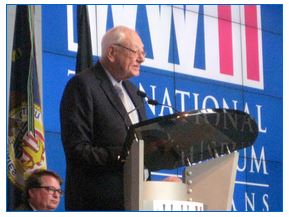
Bob was followed by Gene Geisart, a defense worker who collected and sorted scraps at a plant near his school. “I can’t tell you much about VE Day,” he said. “I finished school and went over to the plant and worked my shift. Everyone was asleep by the time I got home. So I missed it. By the time VJ day came around, I was in the Navy and we were deployed in the Pacific, so I missed that one, too. I am still happy they both happened.”
Both Gene and Bob received warm rounds of applause after their testimony. Then Bill introduced a petite woman named Ann Levey, who was of such diminutive stature that she had to bend the microphones down almost behind the podium. Her voice was soft, but we could hear every word.
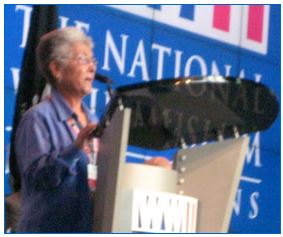
“I was a little girl in a Jewish family,” she said on only mildly accented English. “We lived in Poland and escaped the Warsaw Ghetto. My family worked hard to keep us hidden from the Nazis. It was not a good time to be a Jew in Poland. When we were liberated by the Russians, we realized they were no better than the Nazis, and my parents vowed to get us out to the West. We walked to the Czech Border where we heard there were American soldiers. We made contact with them and explained our situation, and the G.I.s got us on a truck going west to the American Zone in Germany. They were the first soldiers I had ever seen that I was not afraid of.”
We were DPs- displaced persons- for a year before we got on a boat to come to New Orleans. We became American citizens, and my children are American citizens, and that is what VE Day means to me.”
She got a standing ovation when her remarks were done.
Bill closed it out by reminding us that because the war in Europe was over, that did not mean that huge sacrifices did no remain ahead. The Empire of Japan was likely to fight to the bitter end, and hundreds of thousands of casualties remained to come.
So despite the enormous significance of this day, there was still the end of it all to come. He talked about the plans to observe the real end of the World War- VJ Day, Victory over Japan. He introduced s fellow named Andrew Boyd, who manages a web site called NOLA.com and is the picture editor for the Times-Picayune. He called up a remarkable image on the two gigantic video screens on either side of the rostrum. When the residents of St. Roch Avenue heard that Japan had surrendered, they did what comes naturally to any New Orleanian: They held a parade.
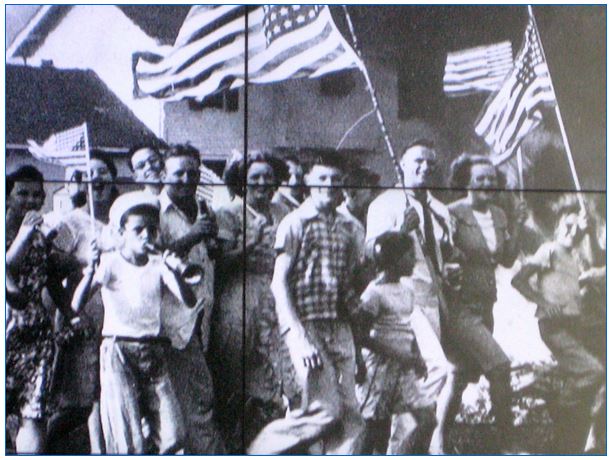
Boyd talked about the man who took the picture with his Speed Graphic camera, Times-Picayune photographer Oscar Valeton, Sr., who captured the impromptu jubilation. His picture sat atop the front page of the newspaper the next morning, which was designated V-J Day. “We are trying to find all the people who are in the picture, and get them to come back to the Museum here on August 15th for the celebration of the final end of the war.”
Bill thanked him, and he thanked the speakers, and he thanked us for attending as he ended the ceremony. People began to get up and start wandering through the galleries, but I took out my Android phone and sent myself a text message: “Be in New Orleans on August 15th.”
It was a grand ceremony in a grand museum. Lest we forget, you know?
Copyright 2015 Vic Socotra
www.vicsocotra.com
Twitter: @jayare303
